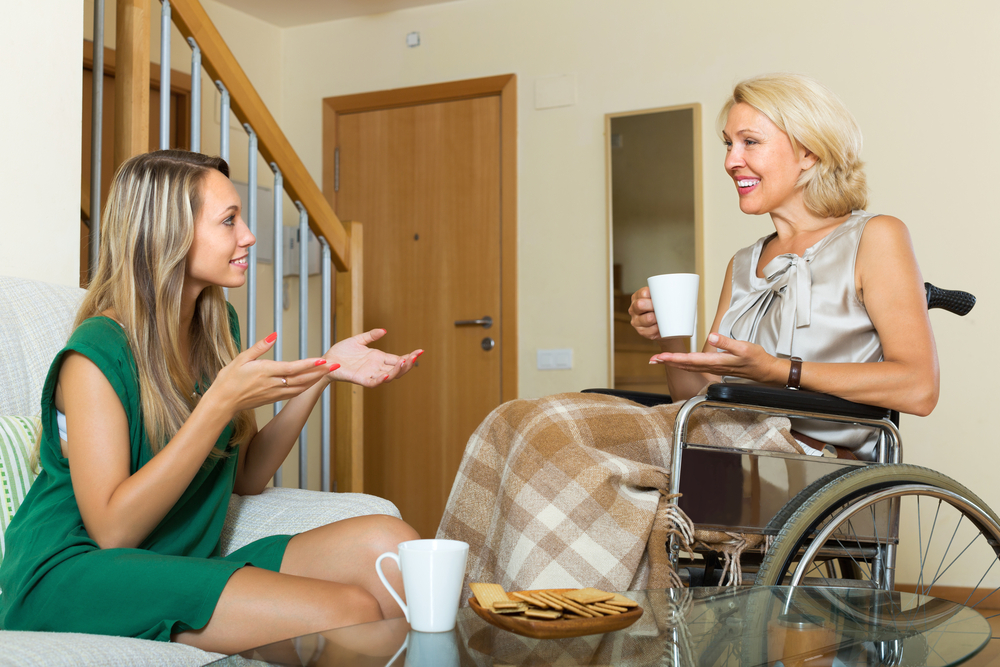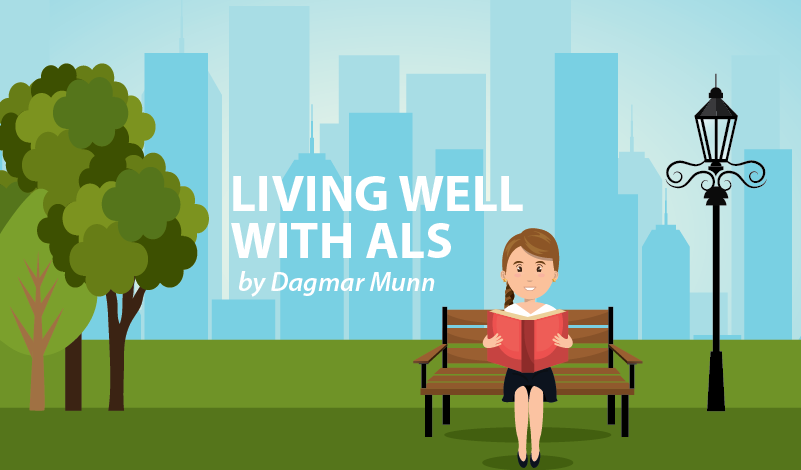What Does ALS Look Like to You?


The other day, while skimming through a list of reader comments on ALS News Today, I ran across one remark that stopped me in my tracks. It was a complaint regarding the photo that accompanies this column. The reader thought the woman in the wheelchair looked too healthy and happy, and suggested using a photo of a person “dealing with ALS.”
Wait a minute! Red flags began waving madly in my brain.
When did having ALS require a certain “look?” And …
Why can’t I be happy and healthy despite living with ALS?
After a few days pondering the issue, I came to the conclusion that ALS does need different “looks” — but for different purposes.
Creating the stock ALS stereotype
First, we have to accept the fact we live in a world of stock photos. Generic images are created more to capture our attention than to provide authentic portrayal. And, ALS is a challenging disease to image. Much like trying to photograph a slow-motion car crash, exactly where in the timeline of the crash or stage of ALS that the shutter clicks creates the model image. Thus we have the choice of either happy and healthy, or sad and apathetic.
Second, we really do need to show more diversity in stock photos. ALS strikes both young as well as older adults. Silver-haired senior citizens aren’t the only ones pushing walkers, rollators and riding electric scooters. Not all caregivers are the wife. ALS strikes moms, daughters and career women as well as men. The stereotype of an elderly person in a wheelchair can be changed by expanding the options we have to select from.
But stereotypes work
I’m still amazed that a disease that affects 450,000 people worldwide and has a lifetime risk of 1 in 400 still needs an awareness campaign. But it does. And I’ll be the first to agree that an image of happy ALS patients doesn’t raise dollars. But videos of ALS-affected football players and celebrities do.
Who is your role model?
The world is made up of optimists and pessimists. As you probably know by now, I consider myself a glass-is-half-full optimist. For example, in my take of the photo above, the woman on the left has ALS and she’s visiting a friend who happens to be in a wheelchair due to some injury or recent surgery.
What image do you hold in your mind: a happy, healthy ALS patient or one who is sad and apathetic?
Why not become your own positive role model?
To help you achieve this goal and bring balance to your life, I share these tips: stick to a daily routine, eat well, sleep well, do moderate exercise, interact with others, have a positive mindset and find a way to express your talents.
Let’s change the “look” of ALS.
***
Note: ALS News Today is strictly a news and information website about the disease. It does not provide medical advice, diagnosis, or treatment. This content is not intended to be a substitute for professional medical advice, diagnosis, or treatment. Always seek the advice of your physician or other qualified health provider with any questions you may have regarding a medical condition. Never disregard professional medical advice or delay in seeking it because of something you have read on this website. The opinions expressed in this column are not those of ALS News Today, or its parent company, Bionews Services, and are intended to spark discussion about issues pertaining to ALS.







Christi Spain
One of the first questions I asked Marilyn Evans of ALS TDI was if ALS only strikes white people. We need all colors represented, as well. ❤️
Joan
Yes!
Diann Freema
No it does not strike White People only. My sister's sister-in-law died of ALS just three days ago.
Mirjana
The women in the picture looks like a part of "stage" photo, it is not about "certain ALS look.
Living with ALS, terminal illness, you can not be as you stated "Why can’t I be happy and healthy despite living with ALS". Healthy and ALS exclude each other.
Dagmar Munn
Yes, Mirjana that is precisely the point - - it is a staged photo. But one I believe was "staged" to show happiness. Happiness can be defined as the ability to live life in a deeply satisfying way. Many with ALS can and do experience happiness every day.
Mirjana
Hi Dagmar.
I pointed out that you can not be healthy and have ALS.
I do not know how someone with ALS can "live life in a deeply satisfaing way".
We all have a moments of happiness in our days, hoping that a new cure is around the corner, so far we can not put our hands on the research promises, they are as far as moon, so is living life in a deeply satisfaing way, we live the best possible life.
Dagmar Munn
I agree with you Mirjana, that physical health is lost with ALS. However, the discussion here is of the photo and the "look" of health, not "having" health. In the early stages of ALS, patients can appear healthy to others.
Emotional health is another factor. Some live with emotional pain, others find ways to give meaning to their lives. We all are different and as the many comments on this topic prove, we have differing opinions - - which in the end is good. All a matter of perspective. And yes, we all seek to "live the best possible life." Thank you for sharing your thoughts.
Charlie
My own positive role model is someone who avidly researches laboratory/clinical developments in the search for a cure for ALS, and who eagerly anticipates the next drug/infusion approval.
Dagmar Munn
I agree with you Charlie - - we should all be active participants in learning about and supporting research and developments towards a cure.
Fouzia
My sister got ALS for year now and she is completely dependant from us for everything cannot move hers arms, cannot eat alone etc... The picture do not reflect the real ALS effects on a patient with this illness .
We want her to be happy and gets the best of life but how
Even with our (family ) great care , sue is suffering every moment .
Dagmar Munn
I am sorry that your sister has ALS and that it has progressed so quickly. It seems that we each hold a different image in our minds of "what ALS is," depending on the stage of the illness that we are acquainted or living with.
Joan
I agree!
Carianne Meystrik
I find this article and author to be offensive and out of touch with reality. Clearly she has no personal experience with ALS. In my 20 years living with ALS, I have never seen these kinds of images. Rarely do we have the luxury of looking put together dressed in clothes that don't factor in how we are going to get on and off the toilet as well as accounting for equipment that often accompanies pALS, such as feeding tubes, bi-paps, vents, catheters, etc, not to mention the hair and make-up. Most of struggle to eat and sleep, can't exercise; what balanced-life pep talk bs. That being said one can still choose to be happy and not apathetic. I am living proof as are many others.
Dagmar Munn
First, congratulations to you Carianne, for your 20 years of living with ALS! I myself have been living with ALS for 7 years now - - so yes, I do have and speak from my own personal experience. And, you are absolutely correct in that we face challenges just to accomplish daily living tasks. You and I may differ in our symptoms but we do share the same outlook: "one can choose to be happy." Thank you for sharing your comments.
Carianne Meystrik
Thank you, and I apologize that I did not know you were indeed personally experiencing ALS. My point is that the majority of pALS don't come close to that stereotype or the famous celebrities or football players who have the resources to make living with this disease a little easier. We need to encourage each other to choose joy, to advocate as research ambassadors, but keeping it real at the same time.
Dagmar Munn
I totally agree with you Carianne! Stereotypes can be helpful as well as harmful. Let's continue to encourage others and share our experiences, while keeping the pressure on researchers to find a cure.
Joan
Well said! Keep it real.
Sondra H
The first thing everyone says to me is, "Your husband looks so good" .
My husband was a healthy 59 year old man with outdoor hobbies and no history of any illnesses. ALS starts to look like what people expect when the limbs atrophy and mechanical assistance is needed, the power wheelchair, the BiPap machine, the specialized vehicle and adapted home. It is difficult to be out in public after a certain point so many people have never met a person with ALS. People have expressed to me that my husband should be out more "like (famous football player)" or "maybe he will survive for years like Stephen Hawking". They have no idea what this disease is like to live with everyday. We need awareness!
Esther
Unlike both women in the photo, my daughter-in-law is paralyzed from the neck down and cannot hold a coffee cup, gesture, hold her head up etc; she is in her 40's, diagnosed just over a year ago, and has not looked like those women in quite a while. In this sense that photo looks TOO happy-happy stock photo. My daughter-in-law smiles a lot as well as cries a lot but doesn't resemble this photo at all.
Dagmar Munn
I am sorry that your daughter has ALS and that it has progressed so fast for her. We are all in different stages of the disease - - which proves to be the challenge in representing ALS in a single photo.
Steve Fornal
This article about what ALS looks like brings up my situation with ALS. I was diagnosed by two Neurologists and the VA in 2012. In April of 2017 I had a four minute examination at the VA which included removing my clothes. After the exam I was told he didn't think I have ALS. This was the first time for this Neurologist to examine me. Keep in mind I attended an ALS clinic for nearly five years at the VA then they decided to dump me. I am a complex case and now I fell into a state of depression and embarrassment that I found very difficult to cope with this change. I fell recently and my non VA Neurologist sent me for a MRI and I was told I have a very serious spinal compression and severe spinal stenosis at my C2-C3 level and I would be at high risk for Quadriplegia if I didn't have surgery. I went to see a Neurosurgeon at UTSW about the spinal issues and was told I have a MND and to see my Neurologist. Additionally with my current Shortness of Breath issues a surgery would be very dangerous for me with MND and restrictive lung disease. I saw a non VA pulmonary doctor and he advised me to not to have a surgery because it would be most likely lead to total ventilator care. Presently I have been on non invasive bipap with use while lying down because without it I stop breathing while sleeping. The point is even doctor's are not sure and noncommittal about ALS if you don't die within the 3-5 yr death sentence ALS generally hands out. Now since I have this spinal cord injury issue even my regular doctor thinks I don't have ALS now. I couldn't even get an appointment with VA for nine months. I emailed them to explain what is happening to me if not ALS and receive no responses back. I told my PCP at the VA but no answers from him. I am left with UTSW telling me I have MND but asking me to see my Neurologists that have now abandoned me to be in limbo about my diagnosis and what to do next. Are there other MND patients out there that are being abandoned by the VA etc non VA doctors after all this time. Keep in mind when I started this journey I weighed 205 lbs and I have managed to keep my weight between 167-172 lbs this past year. I have muscle atrophy, abnormal EMG studies and severe muscle weakness/atrophy in my arms and legs. The EMG findings have not worsened over time and because I have diabetes they say it probably is peripheral neuropathy. I use a cane, walker,and wheel chair for long distances of mobility. Just sharing the invisibility of MND can also be with doctors once you pass the death time frame of 2-5 yrs. Don't get me wrong I was really glad to hear the VA saying I don't have ALS but that only lasted a couple months until UTSW said I do have MND. My health is poor but feeling like no death yet has already transcended into guilt feelings of not dying and frustrations of unknowns without support for medical help. Do you think this happens often to ALS patients living longer than 3-5 yrs? I asked my doctor what he thought about Stephen Hawking and he said, "He doesn't have ALS" it is probably MS"? ALS can be invisible in many ways. I wish they would come up with some kind of positive test to determine diagnosis. sorry for such a long comment but I truly feel abandoned and I still don't know anymore about my health now. I pray this waffling doesn't happen often with MND disease. Thanks for listening.
Dagmar Munn
I am sorry to learn of your bad experiences Steve, in getting diagnosis and treatment. Another challenge we've all had to hurdle is the sheer difficulty in reaching a diagnosis with today's medical technology. ALS/MND is among the many "invisible diseases." More awareness is needed... as well as a cure.
Roger Mishler
You are absolutely correct when stating “looks too healthy to have ALS. Let me tell y’all that a positive outlook is so very much the most beneficial part of dealing with any disease and so very important with ALS. My wife is dealing with ALS and has been for 3 years now and I am her 24/7 caregiver husband. While we have our pity-party’s from time to time, we maintain a positive attitude which is so important for both the ALS person as well as the caregiver!
Charlie
"Let me tell y’all that a positive outlook is so very much the most beneficial part of dealing with any disease..."
I'd say that the most important/beneficial part of dealing with, say, diabetes, is insulin dosage. Once you have your blood sugars under control then you would have the capacity for a very positive attitude, because you would be stabilised.
With ALS, once you have a cessation or reversal of decline in functionality, you can then adopt a very, even an extremely, positive attitude.
Michelle C
Dagmar - I am sorry you are receiving such negativity about a simple photo. I am much more interested in the content of your column than the illustration. As a caregiver for a PALS I completely appreciate the uplifting message and dose of humor you continually share. Please don't let a few negative people bring you down. Seeing your personality through your column, I have no doubt you will keep up the great work and possibly be inspired to do more!
Dagmar Munn
Thank you for your kinds words Michelle. I'm doing fine :-) I believe the outpouring of comments on this topic demonstrates the collective frustration we all feel towards ALS/MND. Sometimes giving everyone a forum to discuss & express frustration can be just as helpful as tips & motivational articles. Sometimes...more so! :-)
Barry Wilson
I accept that dressing in your best clothes is difficult with ALS or MND as we call it in the UK. If I am casual with friends like that in the photo then I wear comfortable clothing but if I go out to a social event then I want to dress for the occasion. Just because we have a disability it doesn’t define how we appear. I believe I appear as a healthy person or so people tell me until I start talking or moving.
patricia
My husband died of ALS and I am offended by the photo. I cannot figure
out what physical limitations she has, as I have never heard of ALS affecting
people only from the waist down while maintaining the ability to balance a coffee cup, speak, smile and have excellent trunk and upper body control.
Dagmar Munn
Patricia, I am so sorry for your loss. ALS symptoms are so varied among those affected it's difficult to give blanket descriptions. Attend any ALS support group and there will be a wide range of stages of ALS. From patients who depend on medical technology for everything to those who walk in and "hold their coffee cup level." True diversity in symptoms. Together we can raise awareness and fight for a cure.
Terry Kent
When we see our beloved husband, wife, fiancé, father, mother, sister, brother, daughter, son or friend battling this disease let's not be bitter towards attempts to gain support and awareness towards understanding and a cure. Not everyone can or should have to face this harsh story. Be kind to others and see the good work amidst our sadness.
Sheila Lowrie
I was scheduled for my first ALS clinic just weeks after I was told I have MND. I was terrified of going to the clinic, afraid of seeing the stereotypical ALS patients knowing that was my fate, I even considered canceling the appointment. The first person I saw was a lovely lady, very put together with hair and make-up done, walking in with the aid of a rollator. She approached me and we started talking, BTW she told me I didn't look like I have ALS and I returned it to her. I learned she has been living with ALS for over 8 years! Meeting her gave me a entirely different outlook on what living with ALS looks like. I left encouraged rather than depressed. When I saw the above picture I didn't think a thing of it........ALS does not have just one face!
Charlie
It appears that progression-rates are different for all pALS. Hail to the slow-progressors, as they have a chance to survive the time needed to find a cure.
Spare a prayer for the fast-progressors. Researchers don't know why some pALS are fast and some are slow.
Researchers really don't have too many answers about any aspect of ALS and there's the problem. From stem-cells to Lunasin, it's all shooting in the dark.
Luck be our lady tonight, and always.
Michelle Kafafi
To me happy and healthy has nothing to do with ALS. Rather it is hard to be happy while you lose everything in your life. I lost my job, financial independence, my friends, my family, cannot leave the house now. How sad. I keep asking is there a cure on the horizon or are we all doomed to die? This is sad. And the incidence of ALS is climbing. Why?
Dagmar Munn
Michelle, yes it is truly hard to be happy in the face of all the loss associated with having ALS. You certainly have experienced more than your share. The one thing I believe we have to hone and rely on - - while we wait for a cure - - is developing resilience. It comes naturally to some folks, is difficult for others and is a topic I've written quite a lot about on my blog site at www.alsandwellness.blogspot.com Perhaps something I've written will be of help to you.
Charlie
A very accurate summary,Michelle. I wish you good luck in our wait for effective treatments, and the ultimate...a cure.
Michelle Kafafi
Charlie I wish you the same. And a very speedy cure for all of us. It has only been 137 years for the Drs and researchers to work on it. This is the most hideous disease that unless you have it you cannot imagine it. It strips everything you have. I cannot find help here to clean, cook, shop. There is no help. Unless you are wealthy you live in filth. I can no longer wash my hair.
Unbelievable.
Charlie I wish for you spontaneous remission and a total healing. Bless us all.
Charlie
http://alsworldwide.org/assets/misc/ALS_treatment_-_Nature.pdf
Fernanda
Hello Roger, I'm from Portugal, and my husband has ALS for 3 years..and things are getting bad each day, Today we saw that was the last day that I can put him inside the car. his lack of strength..and mine as well. How you can support your wife without working? here in Portugal I need to work and pay to someone to care of him :-(...it's so sad...we are 50years old and so many things to do yet :-(
Dale Boyd
Dagmar Munn, The photo is fine. Everyone has their on opinion. My opinion on the Photo is, it doesn't matter what the two young ladies look like. Everyone with ALS looked healthy at the time of diagnosis. It's the non body movements that shows ALS not looks. People don't look healthy when their body is starting to die. I looked healthy when I was diagnosed having ALS. I read your column and didn't even pay attention to the photo.
Larry
It is silly to crticize the photograph or the author. Instead have compassion for the affected person having a moment of happiness.
My wife had already lost the ability to hold a cup when diagnksed six weeks ago. But she still has moments of happiness. I cherish them.
Larry
It is silly to crticize the photograph or the author. Instead have compassion for the affected person having a moment of happiness.
My wife had already lost the ability to hold a cup when diagnosed six weeks ago. But she still has moments of happiness. I cherish them.
Araksya Boyajyan
Hy everyone, 8 years ago I noticed that I couldn't jump with two legs equally, then couldn't run, then walking became worse, after 1 year first foot drop, then 8 month later second foot drop,in2015 October vere given als diagnosis, then 2018 March pma diagnosis, and 2015 October flail legs sindrom, walking with walker, now they said we don't know what is it, they doing genetic tests to find out what is it, my simptoms begins very simmetricali, and proximali in two legs, difficulty go up stairs, low chair,, not jump. Somebody familiar this simptoms
Araksya Boyajyan
I want to talk somebody, about my simptoms , after 8 years I still walk with walker,, have onli legs weaknese, tigh atrophy , and foot drop in two legs, no twitching, no crump, first they said als, then pma, then flail legs sindrom, now doing genetic test to find out what is it
Dagmar Munn
Hello Araksya, That is so good to hear that your ALS has progressed so slowly and that you are still able to walk. And it is also good that you are having a genetic test.
You are invited to join the ALS News Today Forum - - where several hundred ALS patients from around the world discuss their symptoms and share tips. Use this link to find out more: http://alsnewstoday.com/forums/
Araksya Boyajyan
Thank you Dagmar for answering , l like very much your optimizm, yor smile, I have very much depressin since 2015 when they diagnosed als, now in usc research center doctor Bedyin doing genetic testes to find out what diseases I have Dagmar . After 11years do you walking with walker, I have simptoms onli in legs, I am doing all works in home, sweping floor,,making dishes, loking after granddaughters, l am having some hard times, but doing my best
Araksya Boyajyan
Dagmar I have questions after 11 years how ir your hands, or you have only legs simptoms like me, and do you have atrophy in your tigh muscles, I have tigh muscles atrophy that begins very simmetricali in two legs and I think weakneses and atrophy begins together
Dagmar Munn
Araksya, My hands are still functional - - I can use a fork & knife, put on makeup, and even knit. My ankles are weak and I need to use a walker with wheels due to my drop-foot in both feet. So far, I have no atrophy in any of my muscles. Perhaps that is because I am diligent in doing short bouts of exercise throughout my day. These include range of motion, stretching, and gentle strengthening. An example is here:The Power of Just One Squat
You might be interested in reading my various blog posts about how I live with my ALS: ALS and Wellness Blog
Good wishes to you.
Araksya Boyajyan
Dagmar you very positive person. I was wondering mayomo for legs , do you hear about that, my legs not have uper motor neuron sign, onli lower motor neuron sign, l have partial foot drop in two legs and little tighcmuscles atrophy, never us any braces, I read that hands ortosis for stroke, ms and other neuromuscular diseases,